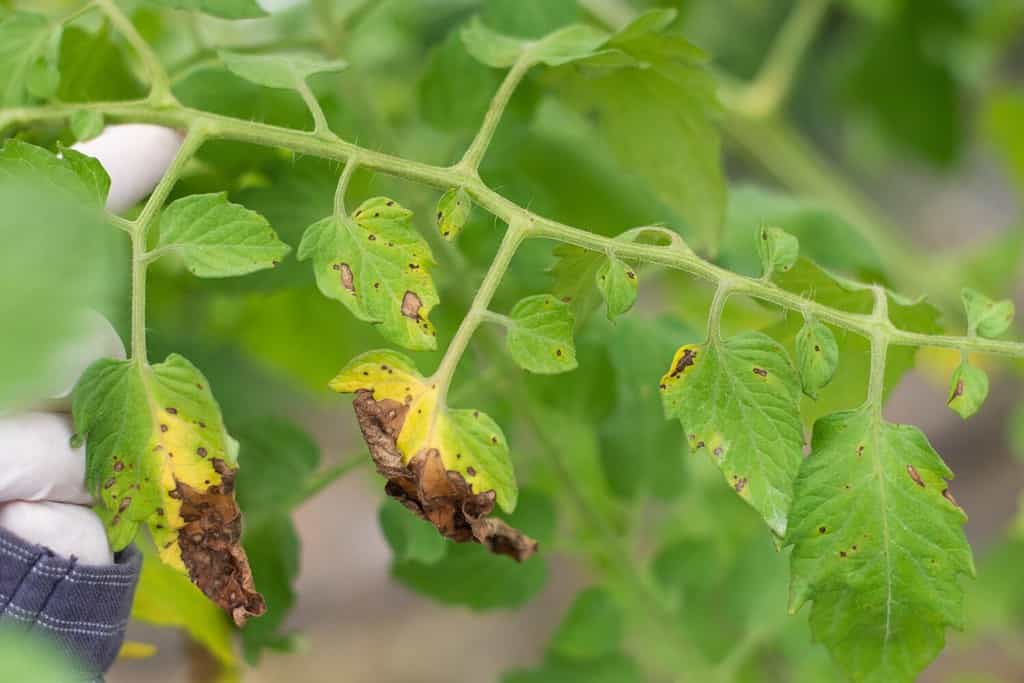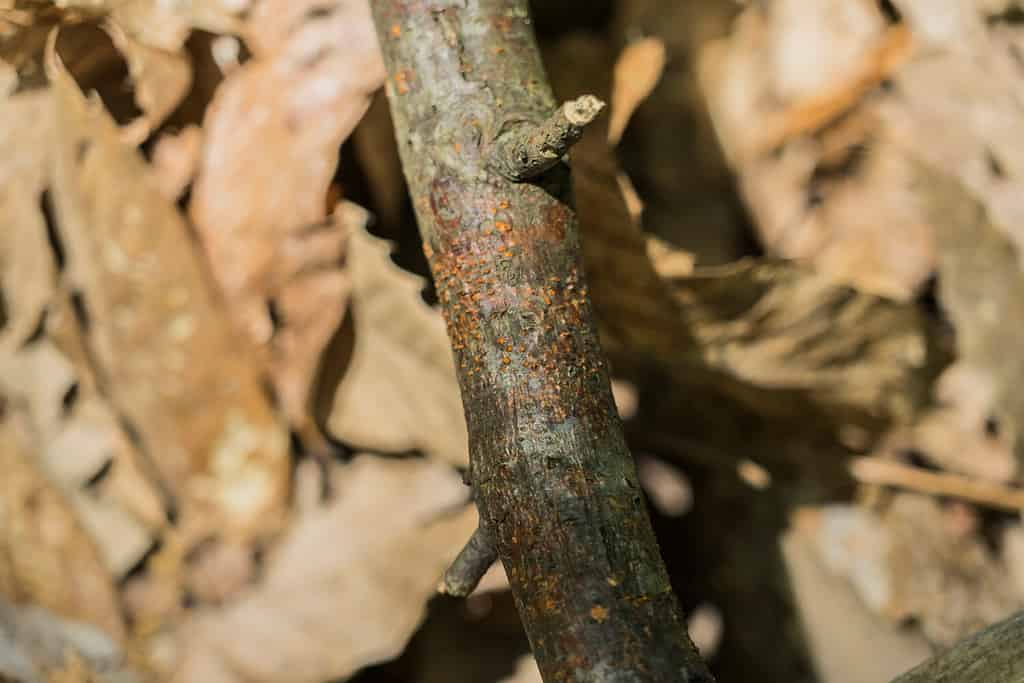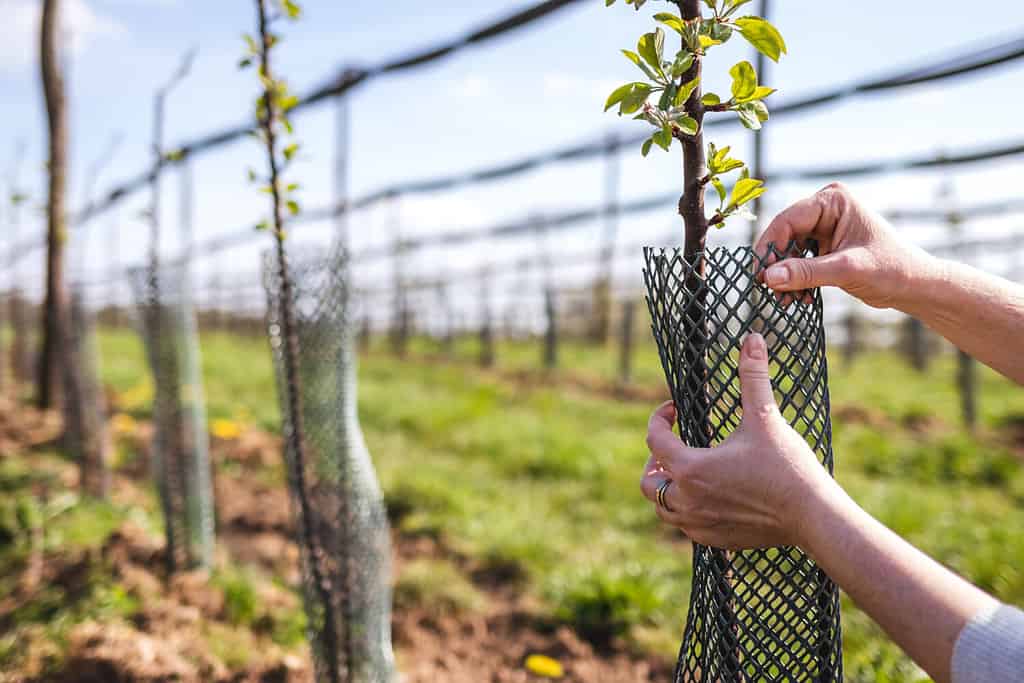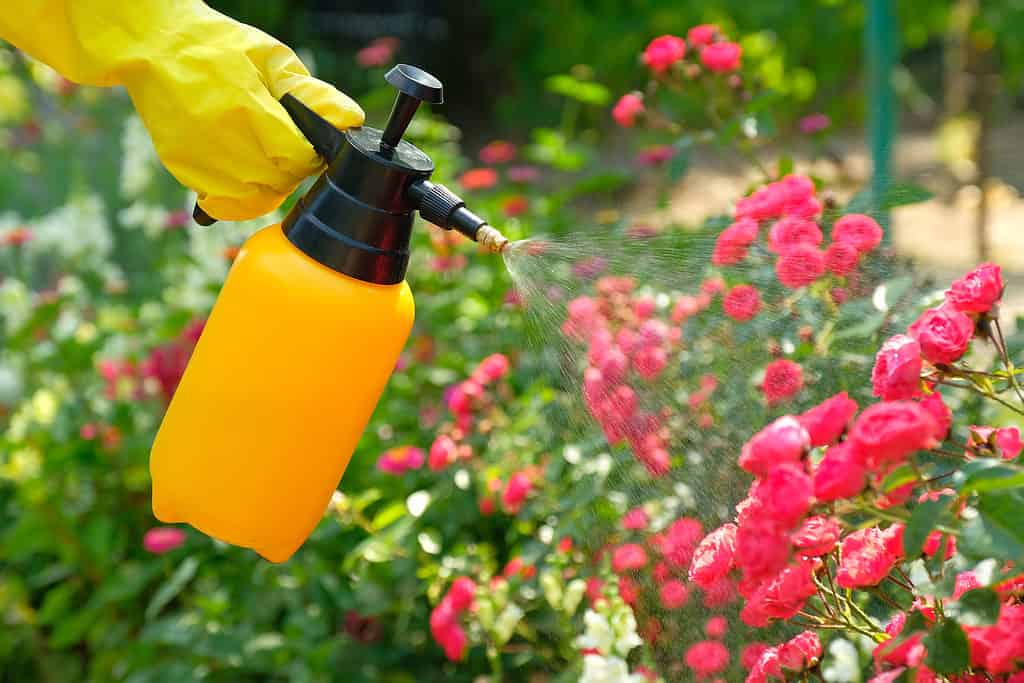
Blight is not dangerous to humans but will kill crops if not handled quickly.
©ukmng/Shutterstock.com
Caring for crops comes with a host of issues from parasites, pesticides, and unwanted intruders stealing a farmer or gardener’s hard work. They spend hours carefully tending to their gardens, ensuring the crops produce a beautiful bouquet of fruits and flowers to enjoy or sell for income. It brings gardeners joy and a sense of accomplishment seeing their strenuous efforts pay off when the first fruits appear on trees or stalks.
However, all that effort can be immediately ruined thanks to blight. The word sends shivers down gardener’s spines, knowing that if their crops are infested with blight, it could destroy everything they spent hours growing.
This article discusses what blight is, how it affects crops, and methods to protect crops from getting blight.
What Is Blight?

Leaves will be the first indicators of blight infection.
©Gondola/Shutterstock.com
Blight is a disease that infects plants with yellow-spotted lesions. These lesions affect all parts of the plant, including the leaves, stems, fruits, and flowers.
The infection will rapidly spread across the whole plant, draining its nutrients until it dies. After, blight will infect nearby plants, repeating the cycle.
Once the first signs of blight are found on plants, there is no way of saving the blight-infested section. However, the rest of the stalk and other plants can be saved if gardeners act fast.
What Causes Blight

Bacteria growing in humid climates quickly spread between plants, causing a blight outbreak.
©cones/Shutterstock.com
Blight is a “catch-all” term to describe a specific infection in plants. The exact cause of blight stems from bacterial or fungal infections. These pathogens are highly contagious to other plants, meaning if one plant is infected with blight, the others will be victims soon.
Additionally, the bacteria grow more rapidly with weather conditions and humidity. Bacteria thrive in warm and humid climates. Gardeners notice blight is more likely to occur after storms, in regions with fluctuating humidity levels, and warm temperatures.
Alternatively, insects and weather carry fungal spores of blight-infested plants to infect other plants.
Bacteria That Cause Blight
Xanthomonas is the most common bacteria to cause plant blight. There are 27 different strains of Xanthomonas which affect different plants but cause similar decay.
Examples of bacteria blight include:
- Xanthomonas campestris: black rot affecting crucifers (broccoli, cauliflower, cabbage, kale, and arugula)
- Xanthomonas oryzae: affects rice and rice fields
- Xylophilus ampelinus: bacteria causing rod-shaped decay in plants and leaves
- Pseudomonas syringae: bacteria that kills blossoms and various fruits
- Erwinia amylovora: “Fire blight” is a bacterium that attacks apples and pear trees, leaving a black or burnt appearance
Fungi That Cause Blight
Incidentally, fungi are capable of causing blight as well, but not as often. Fungus blight will work the same way as bacteria but choose different targets to infect.
The most common types of fungi that cause blight are:
- Cryphonectria parasitica: “chestnut blight” specifically targeting chestnuts and associated plants
- Wilsonomyces carpophilus: “coryneum blight” infects almonds and stone fruit trees. This blight will leave small holes in the leaves, giving it the name “shotgun blight.”
How Does Blight Affect Plants

Late-stage tomato blight will make tomatoes orange and black.
©LianeM/ via Getty Images
There are multiple bacteria that cause blight, but many will have similar symptoms. The bacteria will infect the plants and release a toxin to stop chlorophyll production. Chlorophyll is the substance in plant cells that turns plants green and helps them produce energy through photosynthesis.
Blight stops the production of chlorophyll, sapping the plant’s energy while sabotaging the photosynthesis process. Without sufficient sunlight or energy, the plant undergoes chlorosis, which turns the plants brown until they wither away.
Crops Most Likely to Get Blight
Every plant is susceptible to blight, but certain fruits and crops have a higher risk than others.
The most common plants to experience blight are:
- Tomatoes
- Potatoes
- Apples
- Cucumbers
- Zucchini
- Pumpkin
- Winter Squash
- Rice
How to Identify Blight in Plants

Chestnut blight affects the branches of the trees, making it appear yellow and moldy.
©riccardo.calli/Shutterstock.com
The first step to combating plant blight is recognizing the stages of blight. Gardeners must be attentive to their crops, especially during storms or when humidity is high.
Early Stages
The first stages of blight will arise when the first fruits appear as small, brown lesions on the bottom of the leaves. These lesions will grow to form small, target-shaped rings which will make the leaves feel dry and brittle.
Middle Stages
The lesions will spread to the rest of the plant and fruits, causing a yellow-brown color. The fruits will look damaged or bleached from excess sun exposure. White mildew may grow on lower leaves with the plant slowly decaying.
Late Stages
During the late stages of blight, the entire plant, including the stalk, stem, leaves, fruits, and flowers, will be infected. The plant will look dead or dying with little or no coloring outside of the brown decay or white mildew.
Note that not all types of blight will affect the fruits. Some blight will only target the leaves. However, leaf decay will inadvertently harm the fruit because the leaves are not protecting them from sun exposure. Too much sun will bleach fruits and cause them to spoil.
How to Prevent Plant Blight

Wrapping plants in wiring supports the stalks and prevents contamination of blight.
©encierro/Shutterstock.com
Next, gardeners should seek to prevent blight from infecting their plants before it arises. Prevention is always the best method of protection against pathogens and parasites.
Gardeners can prevent plant blight by following these steps:
- Rotate Crops: Plant crops in different locations every year. This allows the soil time to rejuvenate and replenish itself with fresh nutrients capable of combating pathogens for healthy plant growth.
- Personal Space: Provide plants with enough space to grow without brushing up against one another. In case plant blight does occur, it will have a difficult time infecting other plants if they are not close by. Additionally, better airflow will prevent bacteria from growing in humid areas.
- Plant Supports: Use stakes and trellises for plants to help dry plants faster and minimize leaf contact with soil. Cages will provide protective barriers for vines to grow as well as separate plants to avoid contagion.
- Water the Roots: Avoid watering the leaves and aim directly for the soil to water the roots. Wet leaves may increase the chance of humidity, allowing blight to thrive.
- Mulch: Place mulch around the base of plants to catch possible spores and prevent the blight from spreading into the soil.
- Vigilance: Gardeners should watch their crops carefully, especially during wet and rainy weather. Inspect the plants often for any signs of blight while it is in the early stages.
- Disinfect Tools: Make sure to keep all gardening tools clean and disinfected. Use gloves, a rag, and a solution of one-quarter bleach with four parts water to sterilize all tools after each cut.
- Blight Resistant Crops: Planting crops that are resistant or have a high tolerance to blight can protect the fruits and leaves from decaying if a blight outbreak does happen.
Ways to Eliminate Plant Blight

Follow instructions on bacterial and fungal sprays to protect plants from blight infection.
©Savanevich Viktar/Shutterstock.com
Blight infects a plant slowly, giving gardeners a chance to save the remaining plants and fruits before it becomes detrimental.
Remove Infection
Immediately remove the leaves that show signs of blight infection. Do not place them with other discarded shrubbery or plants because it will spread the infection. Instead, take all the blight-infected leaves, burn them, and then place them in a sealed garbage can. Burning the leaves will destroy the bacterial and fungal spores.
Removing the leaves will be like amputating a finger to save the body. The plants will survive, although some fruits may suffer from sun exposure.
Mulch The Base
Similar to the prevention method, mulch the base of the plant with the blight infection. The mulch will prevent the spores or bacteria from falling into the soil and infect the plant roots, nearby roots, or future plants.
For plants already infected with blight, remove the old mulch, and lay fresh mulch to avoid recontamination.
Blight Removal Products
Look online for high-quality blight removal products. Home improvement and garden sites like Home Depot, Planet Natural, and Grow Organic have several sprays and chemicals to help protect and remove blight from plants without damaging the fruit or stalks.
Remember, by learning more about plant blight, gardeners will be better prepared if and when it infects their harvest.
The photo featured at the top of this post is © ukmng/Shutterstock.com
Thank you for reading! Have some feedback for us? Contact the AZ Animals editorial team.







